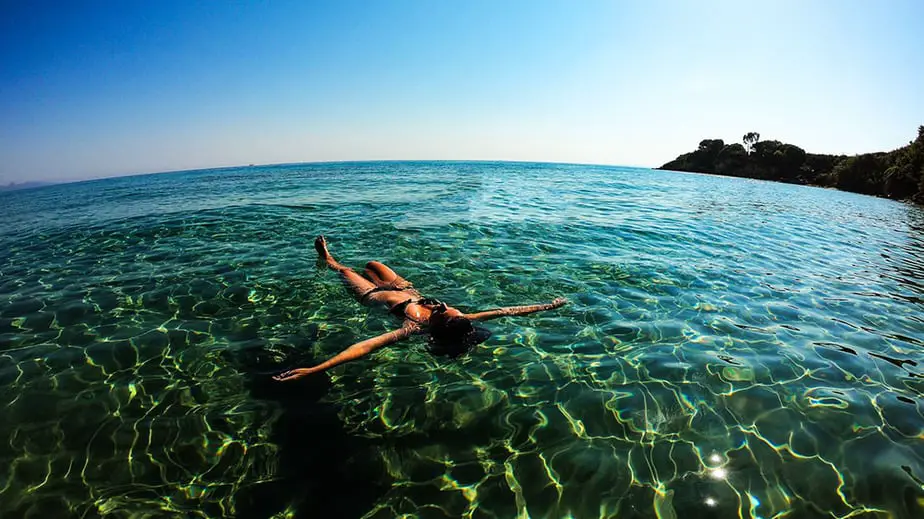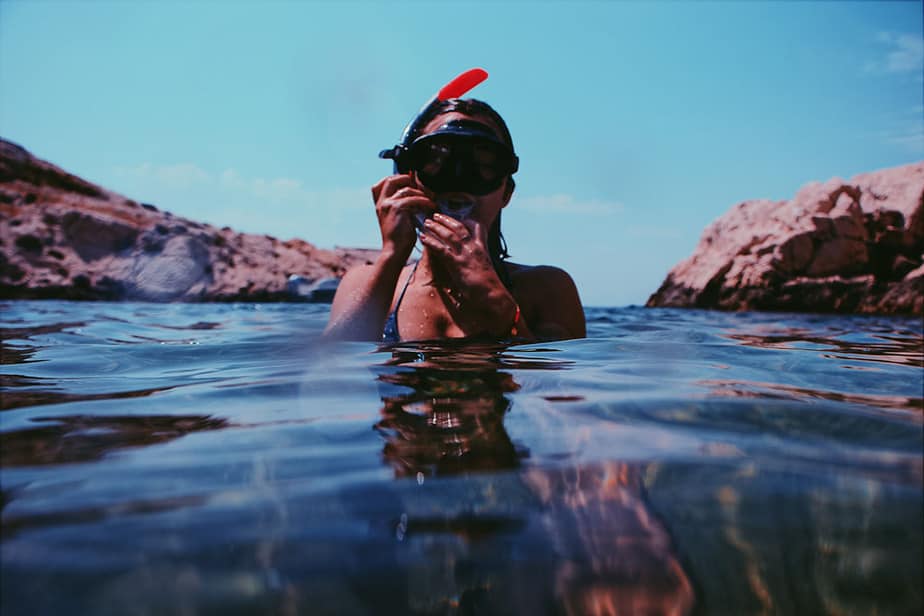Water ski belts are a great tool to help you stay afloat while snorkeling to make the overall experience more relaxing. If you’ve always wanted to try snorkeling but felt left out because you were afraid of the water, then you can use a water ski belt to assist you. Flotation devices such as a swim belt can take the stress out of snorkeling, allowing you to experience the beauty and tranquility of the ocean without worrying about your safety.
With the help of a flotation belt, you can join your friends and family in the water even if you have little to no swimming experience. Additionally, seniors or those with physical disabilities can experience the joys of swimming and snorkeling again. The flotation belt will help them conserve precious energy, allowing them to stay in the water for longer, and keep them afloat in the event of an emergency.
In this guide, we will go over the benefits of water ski belts and how to select the right one to keep you afloat while swimming or snorkeling.
Water Ski Belt Buying Guide
When you are shopping for a water ski belt, there are numerous things to keep in mind. Despite being such a simple device, one should not skimp out on features that could lead to purchasing an ineffective unit that will neither be safe nor comfortable to wear in the water.
The top factors to consider when purchasing a flotation belt for snorkeling are your body type and the intensity of the activity you are planning to use the belt for. Furthermore, you should also consider the material and cut of the belt, which will affect how comfortable it is to wear. Lastly, keep in mind the various belt styles to select from: even-buoyancy belts, uneven-buoyancy belts, and adjustable flotation belts, all of which support the body in different ways.
Body Size
The first thing to evaluate when researching a buoyancy belt is your body type: specifically, your structure and body density. Ask yourself these questions. Is your body broad and muscular? Or is it narrow and lean?
Additionally, who will be wearing the belt – an adult, teenager, or child? Some water ski belts are adjustable and can be shared amongst your family members. Just by asking yourself these questions, you can already get a good idea of the kind of swim belt to look for.
Next, the composition of fat and muscle in your body affects the type of belt you should buy as well. Fat is more buoyant, meaning it floats more easily than muscle. Therefore, lean and muscular individuals have trouble staying afloat and require belts that provide more buoyancy to compensate. People who have less muscle and a higher body fat percentage do not need to get a belt with as much buoyancy support.
Another factor to consider is the age of the individual wearing the belt. Even with adjustable belts, a child should not wear a belt intended for an adult because it might fit loosely and slip off in the water. However, teenagers who are still growing may be perfectly fine with a regular-sized swim belt since they are more likely to fit it than a kid’s belt, plus teenagers can grow into it as well. Always check how snug the water ski belt fits before taking it to the water.
Types of Water Ski Belts for Snorkeling
Even-Buoyancy Belts
An even-buoyancy belt provides an even distribution of foam around your waist, from the front, back, or sides, and helps you easily maintain an upright position. This type of belt is ideal for individuals with poor core strength and feel insecure in the water.
The Hydro-Fit Wave Belt is the picture perfect example of an even-buoyancy belt. It not only provides uniform foam distribution around your waist, but leaves your legs and arms free to move around and reduces drag. Since it can keep you afloat so easily, this belt is often worn by beginners, seniors, or individuals undergoing rehabilitation.
Unfortunately, since this belt keeps you afloat vertically, it can make it difficult to use for snorkeling along the surface.
Uneven-Buoyancy Belts
Yet another popular swim belt design is the uneven-buoyancy belt which typically features more foam around the back of the belt, and less on the sides and front. This higher cut on the back side is suitable for individuals that participate in advanced aqua cardio activities because it continually forces your body forward in the water. Swimmers and snorkelers can take advantage of this since they will naturally be leaning forward as they swim.
In order to remain vertical, one must activate their core muscles to do so. Thus, uneven-buoyancy belts help wearers engage in a great abdominal workout if they wish to remain upright. For snorkelers who plan on floating horizontally with their face looking down into the water, the uneven-buoyancy belt is a fantastic snorkeling belt. We recommend the Aquajogger for snorkelers and water aerobics enthusiasts that hope to incorporate core training into their daily activities.
Adjustable Water Ski Belts
The last type of belt are adjustable water ski belts. With adjustable belts, you can remove the closed cell foam blocks to let you decrease how buoyant the belt is. The square foam blocks are normally attached to the heavy-duty woven belt, however this adaptability is what lets it be a great tool to help beginners learning how to swim.
Snorkeling involves a great deal of swimming, so if you want to improve your swimming skills, consider investing in an adjustable flotation belt to help you practice in a pool. You can also use it to help you lose weight. The floats can be set up to provide an even distribution of buoyancy for newer water aerobics participants, or you can stack all of the foam blocks to the back to imitate the uneven-buoyancy belt.
An example of an adjustable swim belt is the Water Gear Instruction swim belt which features a modular design that lets you remove the foam blocks and is compatible with all kinds of body types and skill levels.
Comfort
Comfort should never be overlooked when you are selecting a buoyancy belt. Unless your snorkeling trips are incredibly short, you will probably be wearing it for several hours at a time. If the belt is uncomfortable enough that you’d rather not wear one and risk drowning, then that is a sign you didn’t consider the comfort aspect during your research.
The materials that a water ski belt is constructed from affect how comfortable it is to wear for long periods of time. Most flotation belts are basically a nylon belt with closed-cell foam attached to it. The foam is soft and buoyant and may be a little stuff the first few times you wear it. However, it should eventually soften as you break it in, and then you will feel like you’re wearing a soft cloud around your waist.
To ensure the optimal fit, check that the belt is long enough to wrap around your waist contour with some space to spare. You can always adjust how snug it fits using the adjustable strap, but it needs to be able to reach around your waist first. Too snug and you’ll feel like it’s cutting off blood flow and cutting into the skin. Too loose and you may feel a sense of freedom, but you run the risk of having it slip off while in the water.
Therefore, the ergonomics (how it is used by you), fit, and comfort are all crucial factors that affect how well the flotation belt will serve you.

Frequently Asked Questions
What is a Swim Belt Used For?
For those who are not confident in their swimming skills, a swim belt is an excellent tool to assist them with floating along the surface of the water. Furthermore, it is also great for older individuals or those with physical disabilities that need extra help staying afloat. Swim belts can also be training tools used by children or non-swimmers to get comfortable in the water in a safe environment.
Some common activities that you may see people use a swim belt for are snorkeling and water aerobics, as well as water-based training regimens. If you’re worried about whether you need to be a strong swimmer to snorkel, just keep in mind that while it is recommended, it isn’t strictly necessary with the help of a buoyancy aid and a snorkeling buddy.
Should I Wear a Flotation Belt for Snorkeling?
Yes, you can and should. It doesn’t matter if you are an experienced snorkeler or a non-swimmer who wants to try snorkeling. Not only does a swim belt help keep you from drowning, which is often a concern for non-swimmers, but it can help seasoned snorkelers conserve energy so that they can stay in the water for longer.
This lets them divert more of their energy and focus on what they truly want to do, which is to observe the underwater flora and fauna in peace. Furthermore, a buoyancy belt is not the only type of snorkel flotation device. You can also wear a life jacket or a snorkel vest to help you stay afloat in the water.
What is Water Aerobics?
Water aerobics, also known as aquatic fitness, is essentially a type of training regimen involving exercises done in shallow waters. They are often done in a swimming pool for the purpose of improving health by improving muscle strength and endurance, heart rate regulation, and lowering stress.
Beginner snorkelers may consider practicing water aerobics to improve their performance in the ocean and while snorkeling. Doing water-specific training will improve your overall skill and confidence in the water, allowing you to perform better when you’re out of the safety of a controlled environment such as the swimming pool.
Can I Use a Swim Belt for Water Aerobics?
Yes, you can use a swim belt for water aerobics and this is a great starting point to get accustomed to using a swim belt. Using a flotation belt frees up your arms when you are doing water aerobics. With this extra freedom, you can do all of the challenging exercises without thinking about how to stay afloat. You can get a greater workout and strengthen your body thanks to practicing this water resistance training.
Conclusion
Every snorkeler both new and old can get some benefit by using a water ski belt for snorkeling. As a newbie, you can get the confidence and protection you need to be in the water. You can also enjoy the underwater sights without reservation. Even seasoned water fitness practitioners and snorkelers can benefit by conserving more energy and snorkeling as long as they want.
A water ski belt for snorkeling is incredibly affordable, yet what it offers you is invaluable. The peace of mind that you get knowing that you’re protected and you can snorkel for significantly longer cannot be put into words, you must simply experience it for yourself. Lastly, they are very versatile, providing benefits to basically all water sports including snorkeling, and is something we highly recommend for all water fitness practitioners.


